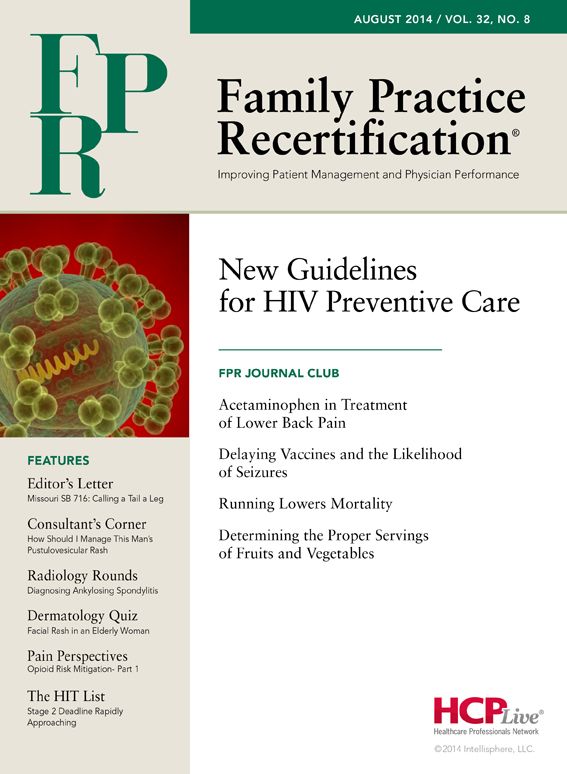How Should I Manage This Man's Pustulovesicular Rash?
A 61 year old male is seen by you for a 3 day history of progressive burning and tingling in the right mid-back area. He reports this morning his wife reports the development of a rash in the area of his symptoms. Examination reveals several grouped pustulovesicular lesions in a right T10 distribution. He denies ever having chickenpox as a child.
A 61 year old male is seen by you for a 3 day history of progressive burning and tingling in the right mid-back area. He reports this morning his wife reports the development of a rash in the area of his symptoms. Examination reveals several grouped pustulovesicular lesions in a right T10 distribution. He denies ever having chickenpox as a child.
What is the differential diagnosis?
Zoster is a common illness - ~20-35% of persons (especially the elderly) in developed countries will develop it - and it should be in the differential for any vesicular rash in an adult. It may be difficult, however, to distinguish common from uncommon etiologies of such a rash. Fortunately, this patient’s rash is limited to one side of the body and one dermatome, narrowing the differential considerably, mainly including varicella-zoster and herpes simplex virus. It is essentially impossible to distinguish HSV disease clinically from herpes zoster, although unlike HSV, no known factors are known to precipitate its appearance. Occasionally, localized enterovirus disease, impetigo, fixed drug eruptions, insect bites, candida, and dermatitis herpetiformis can present similarly. With zoster, the rash usually begins as a red, papular rash which quickly progresses to vesicles (sometimes pustules), usually on an erythematous base. About 75% of patients develop prodromal pain (aches, burning, itching, and various paresthesias) for several days - even weeks) before the rash emerges. Fever is not especially common. This prodromal phase has often led to diagnostic considerations far afield from the actual diagnosis such as angina, cholecystitis, kidney stones, or even appendicitis. If the rash never occurs, the syndrome is known as zoster sine herpetica.
After the rash appears, it will crust over a 7-10 period, with complete healing typically within a month. Post-healing hyperpigmentation can occur and be permanent.
What laboratory tests would you order?
Generally the diagnosis is made clinically and no testing is required, but definitive diagnosis can be made fairly simply. Direct fluorescent antibody (DFA) testing is fast and specific; it is performed in a shell vial system which allows for some viral growth prior to staining. DFA is performed by unroofing a vesicle and scraping the cells at the bottom directly onto a slide. The virus concentrates in the cells versus the vesicular fluid. Polymerase chain reaction testing is also very useful and more sensitive than DFA. Serologic testing does not play a role since shingles is merely reactivation of a prior varicella virus infection which occurs despite preexisting antibodies.
What is his risk for developing post-herpetic neuralgia?
Overall, post-herpetic neuralgia (PHN) occurs in 8-27% of patients and 25-50% of patients over 50 years of age. This patient’s risk for post-herpetic neuralgia (PHN) cannot be precisely predicted, but >80% of patients with PHN are >50 years of age and the risk in 70 year olds is 4 times higher than among 60 year olds. As well, greater severity and/or extent of pain during the rash are also associated with greater likelihood of PHN. Although no standard definition exists, PHN is an important and potentially life-altering complication of zoster and it may last for weeks or months and occasionally years. The pain varies from mild to excruciating, from seconds to minutes in duration to occurring every day. In the placebo arm of various clinical trials, the risk of PHN persisting at least 30, 60, 90, 120 or 180 days was 18-30%, 13-18%, 10-13%, 8.4%, and 5.1%, respectively. PHN may disrupt mobility, sleep, and self-care, cause significant anxiety or depression, and incurs significant economic burdens on society.
What is the role for antiviral therapy?
Treatment, when given, is targeted to preventing complications. Acyclovir, famciclovir, and valacyclovir are safe and well-tolerated and reduce the duration of viral shedding and lesion formation (~1 day), shorten rash duration, lessen severity and duration of acute pain and lower the risk for PHN. All are now generic and acyclovir is the cheapest, but valacyclovir and famciclovir are more bioavailable and therefore require less frequent daily dosing than acyclovir. All patients should be seriously considered for treatment, given the morbidity associated with PHN; especially for those >50 years of age who have moderate or severe pain, moderate or severe rash, or involvement of nontruncal dermatomes. Treatment effectiveness data, however, are only available for initiation of therapy within 72 hours of onset, which often is not practical clinically. Regardless, experts recommend that it should be initiated as soon as possible, particularly in the presence of new vesicle formation or if complications are present. There is no evidence that topical antiviral therapy is useful.
What is the role for corticosteroids?
This topic is still controversial and steroids are not recommended routinely. A 1-3 week tapering course of corticosteroids, however, has been shown to improve acute zoster pain and lower the time to cutaneous healing. Steroids do not, however, impact on the development of PHN nor are they useful for PHN treatment except possibly as an injection into a targeted spinal nerve area. Given the poor adverse event profile of steroids, they should be reserved only for patients with severe disease. Also, no evidence suggests that corticosteroids are useful as a single therapeutic intervention; they should be given with concomitant systemic antiviral therapy.
What infection precautions should be advised?
Uncomplicated zoster in immunocompetent hosts is transmitted (to those who’ve never had chicken pox) through direct person-to-person contact of vesicular fluid. Transmission is only possible from when the blisters appear to when they completely crust over. Persons with localized zoster should minimize scratching, maintain hand hygiene, and avoid contact with susceptible persons at high risk for severe varicella such as pregnant women, premature or low birth weight infants, and immunocompromised persons of all ages. If a person susceptible to varicella infection has close exposure to a person with zoster, post exposure prophylaxis with varicella vaccine or VARIZIG™ should be considered. If the lesion can be completely covered (e.g. covering a back lesion with a shirt) then it is acceptable for the patient to go to work, take public transportation, or come in contact with children. If the patient is immunocompromised in any way, then transmission may also occur via the respiratory route and the patient should not have any public contacts and should stay home.
He does well with treatment with complete resolution of his symptoms and rash. He returns to your office 2 years later for his annual examination and inquires about the shingles vaccine.
Is Zostavax the same vaccine as Varivax administed to children?
No. Both are live, attenuated varicella virus vaccines, but Zostavax is at least 14 times more potent than Varivax and they are not interchangeable. Zostavax was licensed in May 2006, 11 years after the chickenpox vaccine was licensed. Although FDA-approved for use in persons ≥50 years of age, the Advisory Committee in Immunization Practices recommends it only for those ≥60 years of age, as a single dose.
What are the contraindications to Zostavax?
As a potentially transmissible live attenuated virus, Zostavax should not be given to persons with a primary or acquired immunodeficiency. High dose corticosteroids (≥20 mg prednisone or equivalent/day) for >14d is a contraindication to vaccination (defer vaccine for 2 weeks thereafter). Shorter durations of therapy or lower doses of steroid, as well as low doses of a variety of other agents used for rheumatoid arthritis, psoriasis, IBD, etc. (methotrexate, azathioprine, 6-mercaptopurine) are not contraindications to vaccination. Zoster vaccine is contraindicated for persons who have a history of anaphylactic reaction to any component of the vaccine, including gelatin and neomycin. Pregnant women should not receive this vaccine, although having a pregnant women in the vaccinee’s household is not a contraindication to its use.
What are the possible side effects of Zostavax?
Zostavax is generally safe and well tolerated. In the pivotal efficacy trial, the number of serious adverse events (AE) after receipt of vaccine or placebo was low and was similar between groups (1.4%). Rates of serious AEs in the safety substudy, however, were statistically significantly higher in vaccinees (1.9%) than in placebo recipients (1.3%). No temporal or clinical patterns were observed in vaccine recipients to suggest a causal relationship. Injection site AEs (e.g., erythema, pain, swelling, warmth, and pruritis) were more common among vaccine recipients than placebo recipients (48% vs 17%, p<0.05). Most injection site AEs were mild and resolved within 4 days. Less-serious systemic AEs, including headaches, were more common in vaccine recipients than in placebo recipients (6.3% vs 4.9%, p<0.05). The risk for fever after vaccination did not differ between vaccine recipients and controls.
How effective is it at preventing Herpes Zoster and post-herpetic neuralgia?
The pivotal double-blind, randomized, placebo-controlled trial showed that vaccine efficacy, among adults ≥60 years of age for Zoster is 51% (95% CI = 44-58) and 67% (95% CI = 48-79) for PHN. The efficacy is age-dependent, however, and it decreases with age at vaccination for zoster prevention, but does not change by age for protection against PHN (see Table). Vaccine efficacy appears to persist for at least 5 years, but no data are available for longer periods of time post-vaccination.
Age Group
Zoster Incidence
(Vaccine Efficacy 95% CI)
PHN Incidence
(Vaccine Efficacy, 95% CI)
50-59y
70 (54-81)
NA
60-69y
64 (56-71)
66 (20-87)
>=70y
38 (28-52
67 (43-81)
In a patient with no history of varicella, should serologic testing be performed prior to administering Zostavax?
No. Although the pivotal trial only included participants if they had a history of prior varicella infection, the recommendation is to vaccinate without regard for past history.
Should I vaccinate a person with a history of Zoster?
Yes. Recurrent zoster happens frequently and is worthy of prevention. Although the safety and efficacy of zoster vaccine have not been assessed in persons with a history of zoster, different safety concerns are not expected in this group. The CDC recommendation is vaccinate this population as well.
Should you allow time to elapse after a recent episode of shingles before administering Zostavax?
No, but indeed there are no data on this topic. In general, one should not miss the opportunity to vaccinate, consistent with recent guidelines for adult immunization from the National Vaccine Advisory Committee. Importantly, it can be given with pneumococcal and influenza vaccines, as appropriate. One should not, however, use antivirals 24 hours before and through 2 weeks after administration of the vaccine. This is because the vaccine contains live virus and antivirals may weaken the vaccine strain and minimize immunogenicity.
About the Author

Family Practice Recertification
Dr. Zangwill is clinical professor of pediatrics, David A. Geffen School of Medicine at UCLA and Chief, division of pediatric infectious diseases at Harbor-UCLA Medical Center. All questions were posed byEditor-in-Chief Martin Quan, MD.
